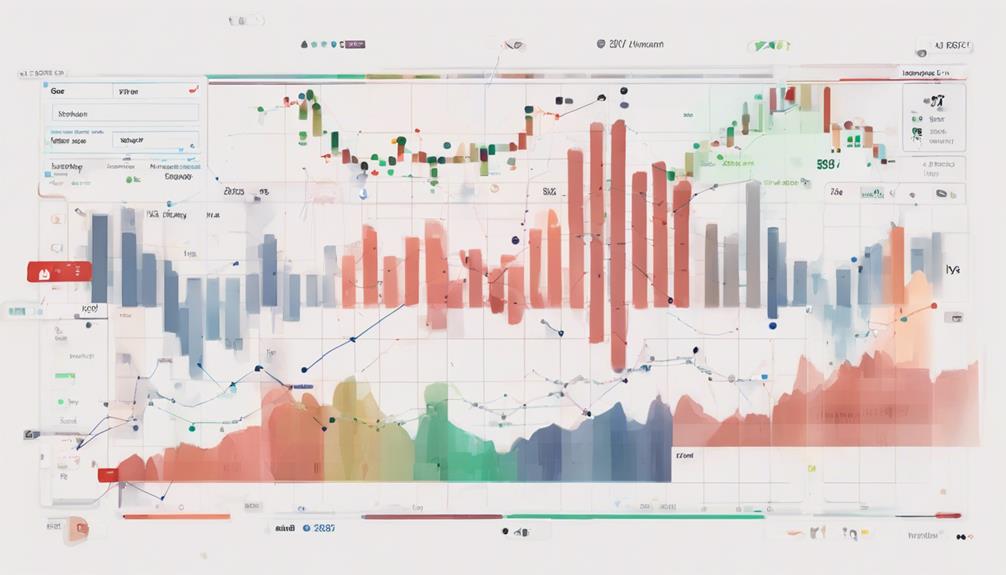Navigating the complexities of Hong Kong stock analysis is akin to deciphering a puzzle with multiple intricate pieces. By exploring the five key techniques tailored for this market, you can enhance your investment decisions and potentially unlock profitable opportunities.
From understanding market structures to implementing risk management strategies, each technique plays a crucial role in your stock analysis toolkit. Let's explore how these strategies can guide you toward making informed and strategic choices in the dynamic Hong Kong stock market.
Understanding Market Fundamentals
To understand market fundamentals in the Hong Kong stock market, you must grasp the operation of the HKEX Main Board and GEM. The Hong Kong Stock Exchange provides a platform for companies to list based on their size and financial standing. When devising investment strategies, consider your risk tolerance as well as the availability of undervalued stocks. The Main Board caters to larger, more established companies, while the GEM is tailored for smaller, growing businesses.
Trading sessions on weekdays offer opportunities to actively engage in the market, with morning and afternoon sessions dictating the flow of investments. Monitoring indices like the Hang Seng Index can give you a pulse on the market's overall health, aiding in decision-making processes. Companies listed on the HKEX adhere to strict financial requirements, ensuring a level of stability and transparency for investors. Understanding these market fundamentals will help you navigate the Hong Kong stock market more effectively and make informed investment choices.
Utilizing Financial Ratios for Analysis

When analyzing stocks in the Hong Kong market, leverage financial ratios like P/E ratio, P/B ratio, and ROE to assess companies' financial health and performance effectively.
The P/E ratio reveals how much investors are willing to pay for each dollar of earnings, indicating the market's perception of the company's growth potential.
Meanwhile, the P/B ratio compares the market value to the book value, offering insights into whether the stock is undervalued or overvalued.
Additionally, ROE measures a company's profitability in generating profit from shareholders' equity.
By analyzing these ratios for Hong Kong stocks, you can gain a deeper understanding of their valuation, growth prospects, and overall financial strength. This analysis is crucial for investors interested in Hong Kong stocks, especially with initiatives like the Stock Connect facilitating cross-border investment opportunities.
Make informed decisions by utilizing these financial ratios to evaluate companies effectively before investing in Hong Kong.
Applying Economic Indicators for Insight

By monitoring key economic indicators like GDP growth, inflation rates, and unemployment figures, you can gain valuable insights into the overall health of the Hong Kong economy. Keeping a close eye on these factors allows you to make more informed decisions when navigating the Hong Kong market.
- GDP Growth: Understanding the rate at which the economy is growing provides a broad view of its health and potential investment opportunities.
- Interest Rates: Changes in interest rates, influenced by the Hong Kong Monetary Authority, impact borrowing costs and investment strategies, affecting various sectors of the economy.
- Retail Sales Data and Trade Balance Data: Examining retail sales data helps in gauging consumer sentiment and spending habits, while analyzing trade balance data provides insights into the country's competitiveness and external economic relationships.
Incorporating Sentiment Analysis for Trends

Incorporating sentiment analysis into stock analysis enhances your ability to identify trends and make informed trading decisions. By analyzing public sentiment through sources like social media, news articles, and financial reports, traders can gauge market sentiment and potentially predict stock price movements. Utilizing natural language processing techniques, sentiment analysis helps interpret and quantify sentiment from textual data sources, providing valuable insights for investors.
Understanding market sentiment shifts is crucial, especially in a volatile international market like the Hong Kong Stock Exchange. The Hang Seng Index, a key indicator of the Hong Kong market, can be influenced by sentiment analysis, guiding investment strategies. By incorporating sentiment analysis into your stock analysis, you can stay ahead of market volatility and adjust your investment strategy accordingly to capitalize on emerging trends. This proactive approach enables you to make more informed decisions and potentially enhance your trading performance.
Implementing Risk Assessment Strategies

To effectively manage risk in the Hong Kong stock market, implement stop-loss orders to automatically sell a stock if it reaches a predetermined price, thereby limiting potential losses in volatile markets.
When investing internationally, especially in the Hong Kong Stock Exchange (HKEX), it's crucial to consider your investment goals and utilize risk assessment strategies tailored to your needs.
Additionally, using options contracts can help hedge against potential downside risk in the market.
Regularly reassess your risk tolerance levels to align with changing market conditions and personal objectives.
Stay informed about regulations and compliance requirements to effectively manage risks associated with investing in Hong Kong stocks.
Employ risk management techniques like diversification and asset allocation to safeguard investments from market fluctuations and unforeseen events.
Invest in Hong Kong with confidence by implementing these risk assessment strategies and staying proactive in monitoring and adjusting your risk management approach.
Frequently Asked Questions
What Are the Five Steps of Fundamental Analysis?
To analyze a company's stock fundamentally, look at company earnings, market trends, industry comparisons, financial statements, and economic indicators. These steps help assess the financial health and intrinsic value of a stock.
What Are the Techniques of Fundamental Analysis?
Wondering about fundamental analysis techniques? Consider market trends, financial statements, economic indicators, industry analysis, and company performance. These factors guide investors in evaluating stocks for potential growth and making informed investment decisions.
What Is the Best Way to Analyse a Stock?
When analyzing a stock, you should evaluate technical indicators, market trends, industry comparisons, financial statements, and valuation methods. These factors provide a holistic view of the stock's potential performance and help you make informed investment decisions.
What Are the Key Ratios for Fundamental Analysis?
To analyze a stock effectively, you need to focus on key ratios like P/E, P/B, and D/E from financial statements. Compare these with industry averages for valuation. Stay updated on market trends for informed decisions.
Conclusion
You've learned the five key techniques for Hong Kong stock analysis.
Did you know that in 2020, the Hang Seng Index had an average daily trading volume of over 2 billion shares?
Imagine the opportunities waiting for you in the vibrant Hong Kong stock market!
Start applying these techniques to make informed investment decisions and seize the potential for growth and profitability.
Happy trading!


